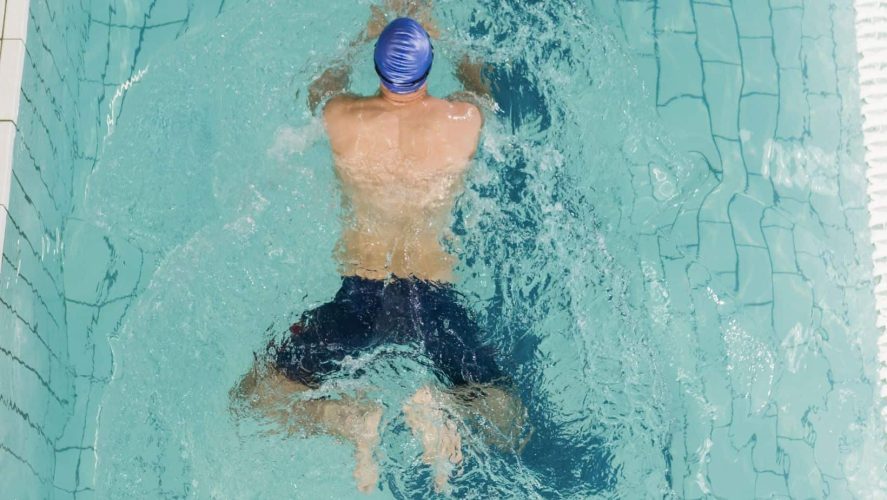Ankle sprains are one of the most common injuries among athletes and active individuals. If you’ve recently sprained your ankle, you may be wondering if swimming is an appropriate activity while you recover. In this article, we’ll look at the benefits and risks of swimming with a sprained ankle and provide tips for staying safe in the water.
What is a Sprained Ankle?
A sprained ankle occurs when the ligaments that stabilize the ankle joint are stretched beyond their limits and tear. This causes pain, swelling, and instability in the ankle. There are different grades of ankle sprains based on severity:
Grade 1 (mild) – Microscopic tears with mild pain and swelling
Grade 2 (moderate) – Partial ligament tears with more significant pain, swelling, and bruising
Grade 3 (severe) – Complete ligament tears resulting in joint instability, extensive swelling, and inability to bear weight
Treatment focuses on rest, ice, compression, and elevating the ankle to reduce swelling. Painkillers and anti-inflammatory medications are used to relieve discomfort. Rehab exercises help strengthen the ankle and improve range of motion. Full recovery can take 2-4 weeks for mild sprains and 4-8 weeks for more severe injuries.

Can You Swim with a Sprained Ankle?
Swimming is often recommended during ankle sprain recovery because it’s a low-impact activity that avoids stress on the injured joint. The buoyancy of water also helps reduce swelling. However, there are some important factors to consider before swimming with a sprained ankle:
Severity – Mild Grade 1 sprains may be fine for gentle swimming after a few days of rest. More severe Grade 2-3 sprains should avoid swimming until cleared by a doctor and swelling has reduced.
Pain – If swimming causes sharp pain, stop. Discomfort and muscle soreness is expected but intense pain can indicate further injury.
Protective Device – A waterproof ankle brace or compression sleeve provides extra support and stabilization in the water.
Stroke – Freestyle and backstroke are lower impact strokes. Avoid breaststroke or vigorous kicking which can aggravate the injury.
Duration – Start with short 10-15 minute swimming sessions to test how your ankle responds before progressing to longer swims.
If you experience increased swelling or pain after swimming, take a break from the water until your ankle is further along in the healing process. Consulting a physical therapist can also help determine when you’re ready for swimming.
Precautions for Swimming with a Sprained Ankle
Follow these tips to stay safe while swimming with an ankle sprain:
- Wrap the ankle in a compression bandage or wear a waterproof brace for extra support.
- Use pool entry/exit points with railings or ladders to avoid bearing weight on the injured ankle.
- Avoid kicks and limit push-offs with your injured leg when possible.
- Stop immediately if you feel any sharp pain and exit the pool.
- Stay well-hydrated – dehydration can increase swelling.
- After swimming, ice the ankle for 15 minutes to reduce inflammation.
- Don’t overdo it – start with shorter swim sessions before building up endurance.
- Listen to your body and don’t push yourself too hard. Proper recovery is crucial to avoid re-injury.

Benefits of Swimming with a Sprained Ankle
While swimming with an ankle sprain requires caution, it offers many benefits during the recovery process:
Improved circulation – Gentle kicking and ankle movements enhance blood flow to promote healing.
Reduced swelling – The hydrostatic pressure of water helps flush swelling and fluid buildup out of the joint.
Maintained range of motion – Controlled movements keep the ankle flexible and mobile.
Muscle strengthening – Water resistance trains muscles that support the ankle without high impact.
Weightless environment – Water supports body weight to prevent re-injury from excessive loads on the ankle.
Mental health – Social benefits and mood boost from exercise in the water.
Swimming allows you to maintain activity levels without overloading the ankle joint as it heals. Always get clearance from a doctor or physical therapist before swimming on an injured ankle.
Alternative Water Exercises
If your ankle sprain is more severe, swimming laps may not be appropriate initially. Consider these lower-impact water exercises instead while recovering:
- Water walking – Use a floatation belt to stay upright while walking through shoulder-deep water. Start in shallow depths.
- Water aerobics – Low-impact class with buoyancy support. Avoid hopping or jumping.
- Pool stretches – Gently stretch and flex the ankle in different directions against water resistance.
- Pool wall push-ups – Face the wall placing hands on the edge, and work on slow controlled push-ups keeping legs buoyant.
- Aquatic therapy – Specialized rehab exercises guided by a physical therapist in the pool.
Progress to swimming laps once you have full range of motion and can bear weight on the healing ankle comfortably.
Conclusion
Swimming can be an excellent low-impact activity during ankle sprain recovery, but requires close monitoring and caution depending on severity. While mild sprains may benefit from gentle swimming, severe injuries initially need more rest. Always consult a doctor or physical therapist to determine safety. When eased back into swimming, the buoyancy, resistance, and hydrostatic properties of water can promote healing. With proper precautions, the pool can support ankle rehabilitation.


